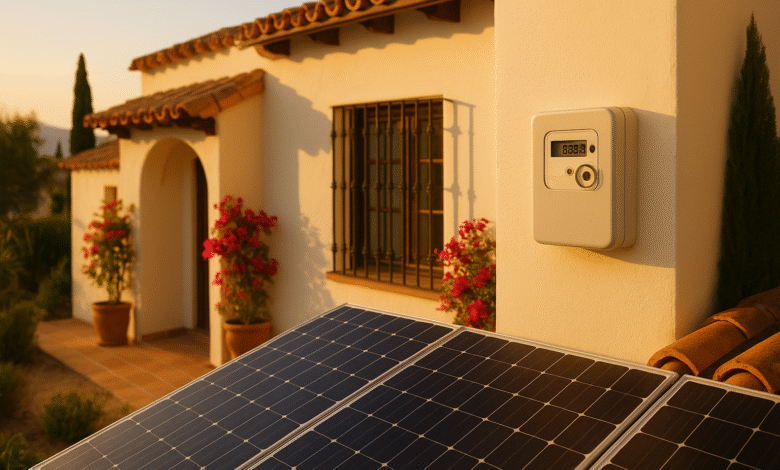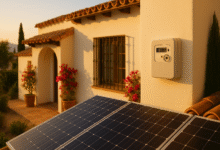
Moving to Spain brings sunshine, slower living, and a lifestyle many dream about. But between those pleasant expectations and reality, there’s a practical side to settling in that catches most newcomers off guard. One of the first surprises many people encounter is the Spanish energy system, which operates quite differently from what you might be used to back home.
Understanding your home energy system in Spain isn’t just about keeping the lights on. It’s about making sense of tariffs that change by the hour, navigating time bands that affect your bills, and figuring out which electricity provider in Spain makes the most sense for your lifestyle. The terminology alone can be overwhelming—PVPC, CUPS codes, contracted power, standing charges—and when everything is explained in Spanish, a simple utility bill can turn into an afternoon puzzle.
This guide breaks down everything you need to know about Spain’s electricity system when you’re settling in. Whether you’re renting an apartment in Barcelona, buying a villa on the Costa del Sol, or relocating to Madrid for work, you’ll learn how the energy market works, what your options are, and how to set everything up without the headache. The goal is simple: get you comfortable with your utilities so you can focus on what actually matters—enjoying your new life in Spain.
Understanding Spain’s Liberalized Energy Market
Spain operates a liberalized energy market, which means you have the freedom to choose your energy provider instead of being locked into a single monopoly. This system was designed to encourage competition and give consumers more control over their energy costs.
The market is split into two main categories: the regulated market (mercado regulado) and the free market (mercado libre). Each operates differently, and understanding which one suits your needs is the first step to managing your energy costs effectively.
The Regulated Market and PVPC Tariff
The regulated market is governed by what’s called the PVPC (Precio Voluntario para el Pequeño Consumidor), or Voluntary Price for Small Consumers. This tariff is available to consumers with contracted power of 10 kW or less, and as of January 2024, only individuals and micro-enterprises can access it.
The defining characteristic of PVPC electricity rates is that prices change every single hour based on wholesale market conditions. Red Eléctrica de España (REE), the national grid operator, publishes the hourly rates each day at 8:15 PM for the following day. This means your bill will fluctuate based on when you use electricity and what the market price is at that moment.
The advantage? If you can shift your consumption to cheaper hours, you can save money. The disadvantage? Your bills are unpredictable, and you need to pay attention to when you’re using electricity. For people who work from home or can run appliances during off-peak hours, this system can work well. For those who can’t adjust their schedules, it can be frustrating.
The Free Market Alternative
The free market electricity Spain offers fixed or semi-fixed rates that you negotiate directly with private providers. Companies like Endesa, Iberdrola, Naturgy, and EDP compete for customers by offering various tariff structures.
With free market contracts, you typically pay a set price per kWh that doesn’t change throughout the day. This gives you predictability—you know what you’re paying regardless of when you use energy. Many providers also offer bundled deals that combine electricity and gas, or provide discounts for specific usage patterns.
The trade-off is that fixed rates are often slightly higher than the average PVPC rate over time. However, for many expats and newcomers, the peace of mind and simplicity are worth the extra cost.
Decoding Spain’s Time Band System
One of the most confusing aspects of the Spanish electricity system for newcomers is the time band structure. Since June 2021, Spain has used a unified tariff system called 2.0TD that divides the day into three distinct periods.
Peak Hours (Punta)
Peak hours are the most expensive time to use electricity. These occur Monday through Friday from 10:00 AM to 2:00 PM and again from 6:00 PM to 10:00 PM. These are the times when demand is highest across the country—people are working, cooking, and using appliances simultaneously.
If you’re on the PVPC regulated tariff, running your washing machine, dishwasher, or electric heating during these hours will significantly increase your bill. Even on fixed-rate plans, understanding these periods helps you make smarter energy decisions.
Standard Hours (Llano)
Standard hours fall in the middle pricing tier. These occur Monday through Friday from 8:00 AM to 10:00 AM, 2:00 PM to 6:00 PM, and 10:00 PM to midnight. The rates during these periods are moderate—not cheap, but not prohibitively expensive either.
For most households, standard hours represent a compromise. If you can’t wait until midnight to run the dryer but don’t want to pay peak prices, these transition periods offer a middle ground.
Off-Peak Hours (Valle)
Off-peak electricity hours are your money-saving window. From midnight until 8:00 AM on weekdays, plus all day on weekends and national holidays, electricity is at its cheapest. These hours account for 53% of the year, giving you plenty of opportunity to reduce costs if you can adjust your habits.
Smart households program their appliances to run during these hours. Dishwashers start at 1:00 AM, water heaters heat overnight, and electric car charging happens while everyone sleeps. If you work from home during the week but can shift heavy usage to weekends, you’ll see the savings add up.
Setting Up Your Energy Supply: The Practical Steps
When you first arrive in Spain, setting up your utilities in Spain is one of the first practical tasks you’ll need to handle. The process is straightforward once you know what’s required.
Essential Documents You’ll Need
Before contacting any energy provider, gather these documents:
- NIE number (Número de Identidad de Extranjero): This is your foreigner identification number, essential for any official transaction in Spain
- Spanish bank account details: Most providers require direct debit payment from a Spanish bank
- Proof of address: Your rental contract, property deed (escritura), or registration certificate (empadronamiento)
- CUPS code: The Código Universal de Punto de Suministro, a unique 20-22 character alphanumeric code that identifies your specific supply point
- Passport or ID: Proof of identity
Understanding the CUPS Code
The CUPS code Spain is like a passport for your electricity connection. This unique identifier starts with “ES” (for España) followed by numbers that identify the distribution company and your specific meter location. Every property has a different CUPS for electricity and another separate one for gas.
You’ll find your CUPS code on any existing electricity bill from the property. If it’s a newly built home that’s never been connected, you’ll need to contact the local distribution company (not the supplier) to have one assigned. The CUPS code never changes, even if you switch providers—it’s tied to the physical location, not the contract.
Choosing and Contacting a Provider
Once you have your documents ready, research which energy providers Spain operate in your area. Major companies include Endesa, Iberdrola, Naturgy, EDP, and specialized providers like Energy Nordic that cater specifically to expats with multilingual support.
You can typically contract services online, by phone, or by visiting a physical office. The provider will handle most of the paperwork, including coordinating with the distribution company if your power needs to be reconnected. The entire process usually takes 5-10 days, though it can be faster if the property already has an active connection.
Switching Providers Made Easy
One positive aspect of Spain’s system is that switching electricity suppliers is remarkably easy. There’s no interruption to your service, no technician visit required, and no early termination fees on most contracts. You simply provide your new chosen supplier with your CUPS code and personal details, and they handle the rest.
This flexibility means you’re never locked in. If you find a better deal or aren’t happy with your current provider’s service, you can switch within weeks.
Understanding Your Spanish Electricity Bill
Your electricity bill Spain contains several components that might look unfamiliar at first. Breaking down each section helps you understand exactly what you’re paying for.
Energy Consumption Charge
This is the variable part of your bill—what you pay for the actual electricity you use, measured in kilowatt-hours (kWh). The rate depends on whether you’re on a regulated or free market tariff. On PVPC, this amount changes based on your hourly consumption and the market price during those hours. On fixed tariffs, you pay the agreed rate multiplied by your consumption.
Contracted Power Charge
This fixed charge is for the maximum amount of electricity available to your home at any given moment. It’s measured in kilowatts (kW) and you pay for it whether you use electricity or not. Think of it like paying for the size of your water pipe, not the water itself.
Since June 2021, you can contract two different power levels: one for off-peak periods and another (typically higher) for peak and standard periods. This flexibility allows you to reduce costs if you only need high power capacity during certain times.
Access Tariffs: Tolls and Charges
These regulated costs cover the transportation and distribution of electricity through Spain’s network, plus policy charges that fund renewable energy subsidies and other system costs. These fees are set by the government and appear as separate line items on your bill.
Taxes
Spanish electricity bills include two taxes. VAT (IVA) is 21% in mainland Spain and the Balearic Islands, 7% in the Canary Islands, and 1% in Ceuta and Melilla. There’s also a special electricity tax (Impuesto Especial sobre la Electricidad) of 5.11%.
Practical Strategies to Reduce Your Energy Costs
Understanding the system is one thing, but putting that knowledge to work is where you actually save money. Here are proven strategies that work for residents in Spain.
Time Your Energy Usage
The single most effective way to reduce costs on a PVPC tariff is shifting consumption to off-peak hours. Program your washing machine to start at midnight. Charge devices overnight. Run the dishwasher after you go to bed. If you have an electric water heater, set a timer so it heats water during valle hours rather than throughout the day.
For people on fixed tariffs, this still matters because lower overall grid demand means providers can offer better rates in the long term.
Choose the Right Contracted Power
Many properties have higher contracted power than they actually need. If you rarely use multiple high-power appliances simultaneously, you might be overpaying. However, setting it too low means your circuit breaker will trip when you exceed capacity.
A typical Spanish apartment might need 3.45 kW to 4.6 kW, while larger homes with electric heating might need 5.75 kW to 10 kW. Analyze your actual usage patterns before deciding.
Invest in Energy Efficiency
Spain’s abundant sunshine makes solar panels Spain an attractive option for homeowners. With installation costs between €6,500 and €10,000 and government subsidies available through programs like PREE, many households achieve payback periods of 5-7 years. The IRPF tax deduction for solar installations varies by region but can range from 20% to 60%.
Even without solar, simple improvements make a difference. LED lighting, A+++ rated appliances, proper insulation, and sealed windows all reduce consumption. Smart thermostats help manage heating and cooling more efficiently.
Consider Your Provider Options Carefully
Don’t automatically stay with whoever supplied the previous tenant. Compare offers from multiple providers. Some specialize in expat services and provide bills in English, German, or Scandinavian languages. Others offer better rates but less personalized service. The best electricity provider Spain for you depends on your priorities.
Common Challenges for Expats and How to Handle Them
Even with preparation, settling into Spain’s energy system comes with potential hiccups. Being aware of common issues helps you navigate them more smoothly.
Language Barriers
Most Spanish energy providers operate primarily in Spanish. Bills, customer service, and online portals may not have English versions. This is where companies specifically serving international residents can be valuable. Energy Nordic, for example, operates in six languages and was built with expats in mind. However, you’ll pay for this convenience, so weigh the value of language support against potential cost savings from Spanish-only providers.
Bill Confusion
Your first few bills might not make sense. Estimated readings, adjustment charges from previous periods, and the multiple line items can be confusing. Keep all your bills and track your consumption. Once you have a few months of data, patterns emerge and it becomes easier to understand.
Power Capacity Issues
Tripping your circuit breaker because you’ve exceeded your contracted power is frustrating. This typically happens when multiple high-draw appliances run simultaneously—electric oven, water heater, washing machine, and air conditioning all at once. Either increase your contracted power or develop awareness of what you’re running concurrently.
Debt from Previous Occupants
Always verify that previous residents have paid all outstanding bills before you sign a contract. You shouldn’t be responsible for someone else’s debt, but getting caught in disputes wastes time and energy. Request written confirmation from the provider that the account has a zero balance.
Renewable Energy and Green Options
Spain is making significant strides in renewable energy, and homeowners have multiple options to participate.
Solar Energy Opportunities
With some of the highest sunshine hours in Europe, Spain is ideal for solar panel installation. Recent regulatory changes have made self-consumption more attractive. Royal Decree 244/2019 eliminated the controversial “sun tax” and established clear rules for self-consumption, including the possibility of shared installations in apartment buildings.
Approximately 74% of multi-family residential buildings in Spain are suitable for rooftop solar installations. Communities can now install collective systems where residents share the generated electricity, potentially reducing bills by up to 40%.
Green Energy Tariffs
Many providers offer green energy tariffs that source electricity from renewable sources. While slightly more expensive, these plans support Spain’s transition away from fossil fuels. Wind energy, which produced 23% of Spain’s electricity in 2021, is particularly important to the country’s renewable mix.
Energy Efficiency Certificates
When buying or renting property in Spain, you’ll encounter the energy certificate (Certificado de Eficiencia Energética). This official document rates a property’s energy efficiency from A (most efficient) to G (least efficient) and must be issued by a qualified technician. While you can’t choose a property solely based on its rating, understanding that a G-rated property will have significantly higher energy costs helps you make informed decisions.
External Resources for Further Support
For official information about Spain’s energy regulations and current tariff rates, the Red Eléctrica de España website provides daily updated PVPC prices and detailed explanations of how the system operates. For broader guidance on living in Spain as an expat, including utility setup and practical advice, Expatica’s guide to setting up utilities in Spain offers comprehensive, regularly updated information in English.
Conclusion
Understanding Spain’s home energy system doesn’t have to be overwhelming. The key is taking it step by step—grasping the difference between regulated and free market options, learning how time bands affect your costs, gathering the right documents for setup, and then optimizing your usage based on your lifestyle.
While the Spanish electricity system might seem complex at first, with PVPC tariffs, CUPS codes, and time-based pricing, it’s actually designed to give you flexibility and control. Whether you choose the predictability of a fixed-rate free market contract or embrace the potential savings of the regulated PVPC tariff, what matters most is finding the approach that fits your needs.
With the foundation you’ve built from this guide, you’re equipped to make smart decisions about your energy in Spain, leaving you free to focus on actually enjoying your new life in the sunshine.











